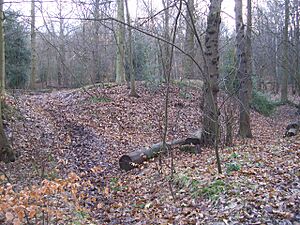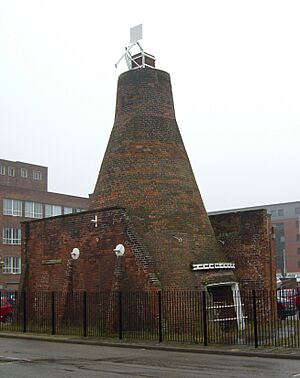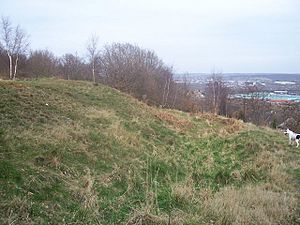Scheduled monuments in South Yorkshire facts for kids
South Yorkshire is home to many amazing historical places! These special spots are called scheduled monuments. They are like super important archaeological sites or old buildings that the government protects.
Imagine a really old castle ruin, a prehistoric stone circle, or an ancient industrial site. These places tell us stories about people who lived long, long ago. To make sure these stories aren't lost, they get put on a special list. This list helps protect them from being changed without permission.
Contents
What Are Scheduled Monuments?
A scheduled monument is a "nationally important" historical place. This means it's super special for the whole country! These sites are protected by law in the United Kingdom. The Secretary of State for Culture, Media and Sport decides which places get on the list.
English Heritage is a group that helps find these important sites. They also make sure they are looked after. There are about 20,000 scheduled monuments across the UK. Sometimes, one entry on the list can even include more than one site!
Why Are They Protected?
These monuments are protected so we can learn from them. They are like open-air history books! Protecting them means future generations can also explore and understand our past.
Sometimes, a scheduled monument might also be a "listed building." Listed buildings are also protected, but in a slightly different way. English Heritage usually thinks listed building status is better for buildings. If a monument isn't considered important anymore, it can be taken off the list.
Some Cool Scheduled Monuments in South Yorkshire
South Yorkshire has many fascinating scheduled monuments. They range from ancient stone circles to old industrial factories. Here are just a few examples:
Abbeydale Industrial Hamlet
Located in Abbeydale, Sheffield, this site is a great example of old industry. It shows how people used to make things like tools and cutlery. You can see old workshops and waterwheels here. It's like stepping back in time to the Industrial Revolution!
Ash Cabin Flat Stone Circle
Near Wyming Brook in Sheffield, you can find this ancient stone circle. It dates back to the Bronze Age. People from thousands of years ago built these circles. We don't know exactly why, but they might have been for ceremonies or marking important events.
Bailey Hill
Bailey Hill is in High Bradfield, Sheffield. This site is what's left of a "motte and bailey" castle. These were early types of castles built after the Norman Conquest. A "motte" is a big mound of earth, and a "bailey" is a courtyard next to it.
Caesar's Camp or Castle Holmes
Found in Scholes Coppice, Rotherham, this is an Iron Age fort. People built these forts on hills for protection. They often had big earth walls and ditches. It shows how communities defended themselves long ago.
Carl Wark
Carl Wark is on Hathersage Moor, Sheffield. It's another ancient site, possibly an Iron Age hillfort. Its rocky location made it a strong defensive spot. The natural landscape was used to create a powerful stronghold.
Doncaster Street Cementation Furnace
In Netherthorpe, Sheffield, you can find this old cementation furnace. This type of furnace was used to make steel. Sheffield was famous for its steel production, and this site shows how that important industry worked.
Roman Rig
The "Roman Rig" is a series of ancient earthworks. Sections of it are scheduled monuments. For example, there's a 550-meter section from Jenkin Lane to Tyler Street in Wincobank, Sheffield. Another 160-meter section is on Wincobank Hill. These earthworks might have been ancient boundaries or defensive lines.
Wincobank Hill Fort
Also in Wincobank, Sheffield, is the Wincobank Hill Fort. This fort dates back to the Late Bronze Age or early Iron Age. It was a very important place for people living thousands of years ago. It was even used during World War II for guns and searchlights!
Images for kids
























